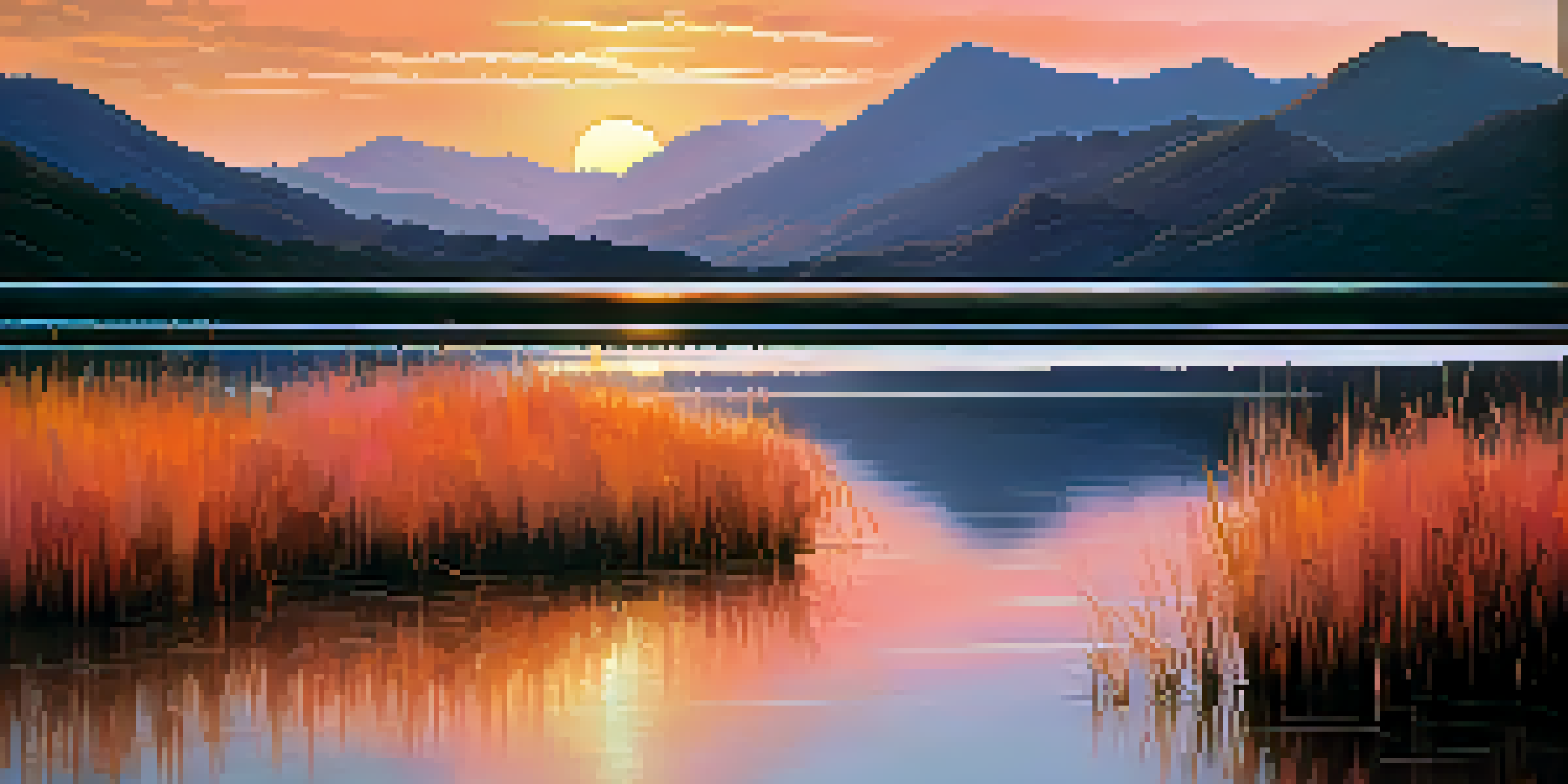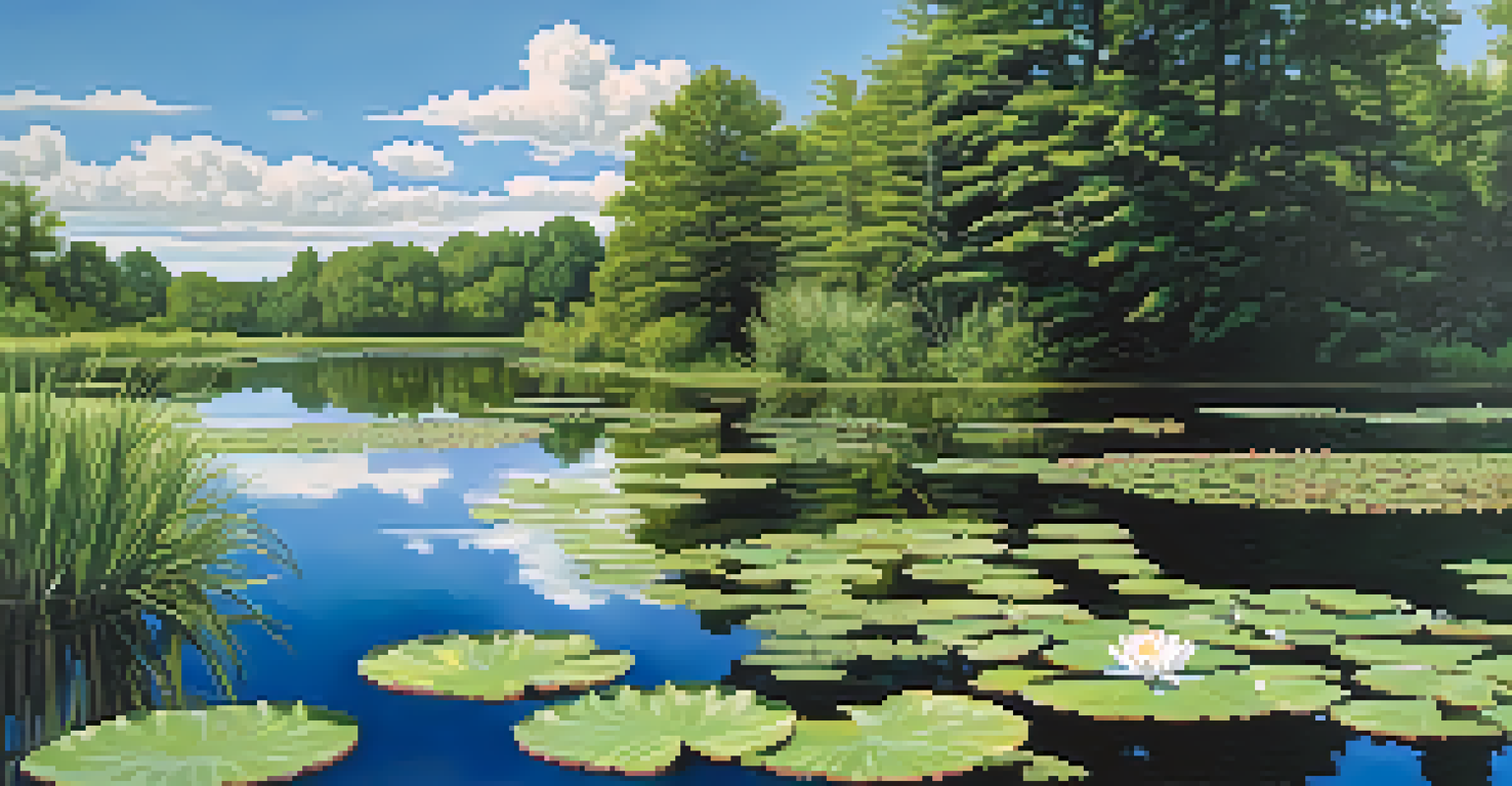Capturing Reflections: Techniques for Water Landscapes

Understanding Reflections in Water Landscapes
Reflections in water can create mesmerizing images, transforming a simple landscape into a breathtaking scene. When you see a clear reflection of trees, mountains, or skies on water, it’s not just eye candy; it’s an opportunity for photographers. Understanding how these reflections work is the first step toward capturing them effectively. The interplay of light, angle, and water surface can all influence what you see and how it appears in your photos.
Photography is the story I fail to put into words.
When the water is still, it acts like a mirror, perfectly reflecting the world above. However, even slight ripples can distort these reflections, creating a different kind of beauty. Think of it as a dance between the elements: the water, the light, and the landscape. By observing these dynamics, you can anticipate how to compose your shots for maximum impact.
Moreover, the time of day plays a crucial role in reflection photography. During golden hour, for example, the warm light can create enchanting colors in the water. Understanding these nuances will help you make informed decisions about when and where to shoot, leading to more compelling images.
Choosing the Right Location for Water Photography
Location is everything in photography, and when it comes to water landscapes, it becomes even more critical. Ideal spots include lakes, rivers, and even urban settings with fountains or ponds. Each location brings its unique character, so take time to explore different areas to find what resonates with you. Consider the surrounding elements, as they can enhance the reflections you aim to capture.

For instance, a serene lake surrounded by mountains can yield dramatic reflections, whereas a bustling cityscape mirrored in a river offers a modern twist. You might even discover hidden gems in your local area that provide stunning visual opportunities. Remember, sometimes the best locations are just a short drive or a walk away.
Mastering Light for Stunning Photos
Understanding the optimal lighting conditions, such as golden hour and overcast skies, can significantly enhance the quality of reflections in your water landscape photography.
Another vital aspect to consider is accessibility. Choose locations that are safe and easy to reach, especially if you plan to carry heavy equipment. Scouting your chosen spot ahead of time can save you from surprises on the day of your shoot.
Optimal Lighting Conditions for Capturing Reflections
Lighting can make or break your photos, especially in water landscapes where reflections are involved. The best times for shooting are during the golden hour—right after sunrise or before sunset—when the light is soft and warm. This gentle illumination not only enhances the colors of the surroundings but also creates stunning reflections in the water.
The best camera is the one you have with you.
Overcast days can also be advantageous, as they provide diffused light that reduces harsh shadows. This type of lighting can create a moody atmosphere, perfect for capturing serene reflections. Experimenting with different weather conditions can lead to diverse and compelling images that tell a story.
Additionally, consider the direction of the light. Shooting with the sun behind you will illuminate the landscape and enhance reflections, while shooting into the sun can create dramatic silhouettes. Understanding how to manipulate light will elevate your photography skills tremendously.
Camera Settings for Perfect Water Reflections
Choosing the right camera settings is crucial for achieving stunning water reflections. Start by setting your camera to a low ISO, ideally between 100 and 200, to minimize noise and enhance image quality. A low ISO paired with a slow shutter speed can enhance the smoothness of the water's surface, creating those beautiful, mirror-like reflections.
Aperture settings also play a significant role. A wider aperture (lower f-stop number) can blur the background, drawing attention to the reflections, while a smaller aperture (higher f-stop number) will ensure more of the scene is in focus. Finding the right balance for your composition will make your images pop.
Choose Locations Wisely
Selecting the right location, whether a serene lake or an urban fountain, is crucial for capturing unique and compelling reflections that resonate with viewers.
Lastly, don't forget to use a tripod. This will help stabilize your camera, especially when using longer exposure times. A steady shot is essential for capturing the clarity of reflections in water landscapes.
Incorporating Leading Lines in Your Composition
Leading lines can be a powerful composition tool in water landscape photography. These lines guide the viewer’s eye through the image, creating depth and interest. Look for natural lines such as rivers, shorelines, or reflections that can draw attention to the focal point of your photograph.
For instance, a winding path beside a lake can lead the eye toward a stunning mountain reflection in the water. Using these lines effectively can create a sense of movement and flow, making your images more engaging. It’s all about creating a visual journey for your audience.
Remember to consider the rule of thirds when incorporating leading lines. Placing your subject off-center can yield a more dynamic composition, allowing the leading lines to take center stage in guiding the viewer through the scene.
Experimenting with Different Perspectives
Sometimes, the best shots come from unexpected angles. Don’t be afraid to get low to the ground or find a higher vantage point to capture your reflections. Changing your perspective can yield uniquely compelling images that stand out from the typical water landscape shots.
For example, shooting from a low angle can emphasize foreground elements like rocks or plants while capturing stunning reflections of the sky above. Alternatively, a high perspective might showcase the broader landscape and its relationship with the water below. Each angle tells a different story.
Experiment with Camera Techniques
Utilizing the right camera settings, perspectives, and post-processing techniques can elevate your water reflection photography to new heights.
Additionally, using a wide-angle lens can help capture more of the scene, including both the landscape and its reflection. Experimenting with your perspective not only adds variety to your portfolio but also enhances your creative vision as a photographer.
Post-Processing Tips for Enhancing Water Reflections
Post-processing is where the magic happens, turning good images into great ones. Start with basic adjustments such as exposure, contrast, and color correction to ensure your reflections look as stunning as they did in real life. Software like Adobe Lightroom or Photoshop can be invaluable tools for enhancing your images.
Consider sharpening your reflections to make them pop. A subtle increase in clarity can help define the details and make the water look more vibrant. However, be cautious not to overdo it, as too much sharpening can create unnatural effects.

Finally, don’t shy away from using filters during post-processing. A polarizing filter, for instance, can reduce glare and enhance the colors of both the water and the reflections. This can transform an ordinary shot into an extraordinary one, highlighting the beauty of water landscapes.